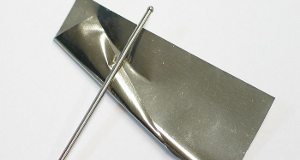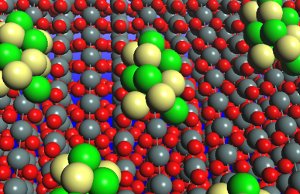The chemical element rhodium is classed as a transition metal. It was discovered in 1803 by William H. Wollaston.

Data Zone
| Classification: | Rhodium is a transition metal |
| Color: | silvery-white |
| Atomic weight: | 102.9055 |
| State: | solid |
| Melting point: | 1963 oC, 2236 K |
| Boiling point: | 3695 oC, 3968 K |
| Electrons: | 45 |
| Protons: | 45 |
| Neutrons in most abundant isotope: | 58 |
| Electron shells: | 2,8,18,16,1 |
| Electron configuration: | [Kr] 4d8 5s1 |
| Density @ 20oC: | 12.4 g/cm3 |
Reactions, Compounds, Radii, Conductivities
| Atomic volume: | 8.3 cm3/mol |
| Structure: | fcc: face-centered cubic |
| Hardness: | 6.0 mohs |
| Specific heat capacity | 0.242 J g-1 K-1 |
| Heat of fusion | 21.50 kJ mol-1 |
| Heat of atomization | 556 kJ mol-1 |
| Heat of vaporization | 493.0 kJ mol-1 |
| 1st ionization energy | 719.8 kJ mol-1 |
| 2nd ionization energy | 1744.4 kJ mol-1 |
| 3rd ionization energy | 2996.8 kJ mol-1 |
| Electron affinity | 109.7 kJ mol-1 |
| Minimum oxidation number | -1 |
| Min. common oxidation no. | 0 |
| Maximum oxidation number | 6 |
| Max. common oxidation no. | 3 |
| Electronegativity (Pauling Scale) | 2.28 |
| Polarizability volume | 8.6 Å3 |
| Reaction with air | mild, w/ht, ⇒ Rh2O3 |
| Reaction with 15 M HNO3 | none |
| Reaction with 6 M HCl | none |
| Reaction with 6 M NaOH | – |
| Oxide(s) | RhO2, Rh2O3 |
| Hydride(s) | – |
| Chloride(s) | RhCl3 |
| Atomic radius | 134 pm |
| Ionic radius (1+ ion) | – |
| Ionic radius (2+ ion) | – |
| Ionic radius (3+ ion) | 80.5 pm |
| Ionic radius (1- ion) | – |
| Ionic radius (2- ion) | – |
| Ionic radius (3- ion) | – |
| Thermal conductivity | 150 W m-1 K-1 |
| Electrical conductivity | 23 x 106 S m-1 |
| Freezing/Melting point: | 1963 oC, 2236 K |

Rhodium pin and foil. Photo by Dschwen.
Discovery of Rhodium
Rhodium was discovered in 1803, in London, by English chemist William H. Wollaston, when examining a platinum ore from Peru. (1)
Wollaston was first alerted to the possibility of a new element by Hippolyte-Victor Collet-Descotils, who believed that the red color of some platinum salts was actually caused by the presence of an unidentified metal. (2)
To investigate this possibility, Wollaston first dissolved crude platinum in aqua regia, a concentrated solution of hydrochloric and nitric acids. He then precipitated platinum metal by dissolving the solution in ammonium chloride.
The liquid which remained had properties which matched no known substance. (2)
Wollaston conducted a series of chemical reactions on this liquid before producing a deep red powder, sodium rhodium chloride, RhCl6Na3.12H2O, which gave a black, flaky precipitate of rhodium when treated with zinc. (1)
The element name comes from the Greek word ‘rhodon’ meaning rose. Wollaston chose this name because of the rose color of a dilute solution of rhodium’s salts.
1803 was a good year for William Wollaston. Not only did he discover rhodium, he also discovered another platinum group metal – palladium.
The Platinum Group Metals
These metals have similar properties and are often present in the same mineral ores.
| 44 Ru |
45 Rh |
46 Pd |
| 76 Os |
77 Ir |
78 Pt |


Catalyst for ethanol oxidation: platinum-rhodium clusters on a surface of tin dioxide. This catalyst can split the carbon-carbon bond and obtain energy from ethanol in fuel cells. Image by BNL. (3)
Appearance and Characteristics
Harmful effects:
Rhodium is considered to be non-toxic. Some of its compounds are highly toxic and carcinogenic.
Characteristics:
Rhodium is a rare, hard, silvery-white, lustrous metal.
It is one of the of the six platinum group metals consisting of platinum, palladium, rhodium, osmium, iridium and ruthenium.
It is highly reflective and extremely resistant to corrosion.
It is not attacked by most acids.
When present in compounds, rhodium exists mostly in the trivalent state, Rh3+.
Rhodium’s salts form rose-colored aqueous solutions.
Uses of Rhodium
The majority of rhodium is used as a catalyst in catalytic converters. It is also used to catalyze industrial processes.
Rhodium is used as an alloying agent for hardening and improving the corrosion resistance of platinum and palladium.
As a result of its low electrical resistance, low and stable contact resistance, and its stability against corrosion rhodium is used as an electrical contact material.
The metal is used in jewelry and for decorations.
Abundance and and Isotopes
Abundance earth’s crust: 1 part per billion by weight, 0.1 parts per billion by moles
Abundance solar system: 2 parts per billion by weight, 0.02 parts per billion by moles
Cost, pure: $13,000 per 100g
Cost, bulk: $7,000 per 100g
Source: Rhodium occurs in small quantities in ores metals such as platinum, palladium, nickel, silver, and gold. Commercially, it is obtained as a byproduct of refining nickel sulfide ores from Canada.
Isotopes: Rhodium has 24 isotopes whose half-lives are known, with mass numbers from 94 to 117. Naturally occurring rhodium consists of its one stable isotope, 103Rh.

References
- J.W. Mellor, A Comprehensive Treatise on Inorganic and Theoretical Chemistry Volume XV, 1936, Longmans, Green and Co., p545-546.
- William Nicolson, A Journal of Natural Philosophy, Chemistry and the Arts, Volumes 9-10, 1804, W. Stratford, p34-35.
- Photo: BNL.
Cite this Page
For online linking, please copy and paste one of the following:
<a href="https://www.chemicool.com/elements/rhodium.html">Rhodium</a>
or
<a href="https://www.chemicool.com/elements/rhodium.html">Rhodium Element Facts</a>
To cite this page in an academic document, please use the following MLA compliant citation:
"Rhodium." Chemicool Periodic Table. Chemicool.com. 18 Oct. 2012. Web. <https://www.chemicool.com/elements/rhodium.html>.